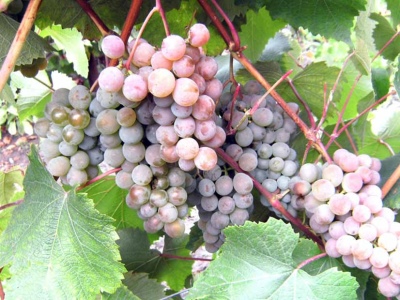
- Authors: TsGL im. I.V. Michurina
- Appointment: universal
- Berry color: pink
- Taste: original
- With bones: Yes
- Ripening period: early
- Ripening period, days: 110-120
- Frost resistance, ° C: -25
- Name synonyms: Summer scent (New variety)
- Bunch weight, g: 500
Many people know that grapes mainly grow in the southern regions and take root in the central or northern regions. Therefore, it is very difficult to find a variety with high frost resistance. Grapes Pearls Pink is just one of the frost-resistant varieties.
Breeding history
This culture takes its roots from the Pearl grape variety, which was bred in Hungary. To obtain, we took two types: Hungarian Muscat and Ottonel Muscat, from which a new variety of Pearls Saba was obtained. Later, on the territory of Russia, it was crossed and pollinated with other varieties, after which Pearl Pink was born, which was bred at the Academy of Agricultural Science in Michurinsk.
Description
This crop belongs to the universal varieties. This means that the product can be used both for home cooking (preserves, jams) and for winemaking.
The bushes have average growth rates, semi-creeping shoots. The vine ripens well and becomes firm. Culture needs to be supported by something, so many plant it next to arches.
The leaves are bright green, the blades are weak, there is a jagged edge. The leaves themselves are small, with light villi on the back.
Flowers are rather small, collected in one brush.
Poor portability can be considered one of the downsides.
Ripening period
In terms of ripening, it belongs to the early varieties. On average, the growing season lasts from 110 to 120 days. Flowers appear in May, and the first fruits can be harvested in the first half of August.
Bunches
The bunches are medium-sized, with an average density, in some places you can find looseness. The shape of the brush is conical, small in size, with a short ridge. By weight from 300-500 g.
Berries
The berries are medium and small - 3-5 g. Light yellow in shade with a green tint, when fully ripe, the color goes more into pink with a golden tint. They are firm and round in shape, the skin is thin and smooth with a slight sheen. There are few seeds inside, the pulp is juicy and fleshy.
Taste
This variety has an original sweet taste, with nutmeg notes. The sugar content is on average up to 25%, and the acidity is up to 9 g / dm3.
Yield
Up to 6 kg of berries are harvested from one vine; with proper feeding and cutting, the crop can grow up to 8 kg. Fruitful shoots 65-85%.


Growing features
For planting Pink Pearls, it is worth choosing the sunny part of the site. It is necessary to plant in the spring, in the southern regions, planting can be done in late April - early May, but in the northern regions it is better to wait for June and plant seedlings in the 20th.
Grapes should not be watered often and abundantly, or choose soil that does not dry out well - the roots of this culture may begin to rot. If, nevertheless, the site can be flooded, then it is worth considering drainage systems.
The ideal soil will be clay or black earth. The acidity must be neutral, otherwise the seedling will not take root.
Landing
Disembarkation should be carried out at a specially designated place. The distance between the pits should be 1.5-2 m, and between the rows 2-3 m. The depth of the fossa should be 0.5-0.8 m, diameter - 0.8 m. Drainage must be placed at the bottom. Pebbles or broken bricks will do. Sprinkle a little with fertile soil. Further, a seedling is lowered into the hole, the earth is buried and compacted around the branch. Spill with water, on average it takes half a bucket.

Pollination
This species has flowers of both sexes, so there is no need for additional pollination.
Pruning
The first pruning should be carried out in the first year before planting; excess branches and roots are trimmed. In the second year, 2-3 eyes are cut off. It is necessary to begin to form a bush, to make supports on which branches will be suspended. Then, after each winter, the bushes are inspected for dry, broken branches or those that have not survived the winter. And also it is necessary to thin out the bushes, especially those vines that began to grow in the wrong direction.
It is worth leaving only 30 eyes on the vine per season. This is the most acceptable load on the bush for this species.



Frost resistance and the need for shelter
The frost resistance of the variety is up to -25 degrees. With light frosts down to -18, the bushes need not be covered with a special covering. But if the temperature drops below, then it will be necessary to cover the bushes in order to avoid freezing of the vines.

Diseases and pests
The variety is subject to disease and pest attacks. Among fungal diseases, this is mildew. And among the pests are phylloxera, grape and spider mites, leafworms and wasps.

If a grape is exposed to any disease or insect, this always affects its appearance.
Storage
Harvesting Pink Pearls should be done in a timely manner, do not leave the berries overripe, as they will lose their taste. But it is also not worth removing the bunches immature, they will not be suitable for further storage.
Can be stored in a dimly lit place with a humidity of no more than 70%, at temperatures from zero to +2 degrees. Some gardeners even freeze these berries.











































































